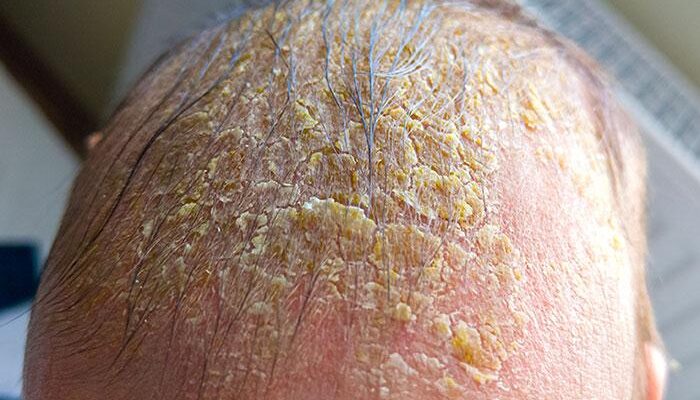You might be astonished about your baby’s flaky scalp. This is nothing but a cradle cap. Around every 3rd baby gets affected by this condition at least once in life. It’s not a big issue, but the condition might look uncomfortable for parents like you.
It no longer stays on the baby’s scalp and fades out, but in some cases, it remains intact or starts spreading on the face, body, and other parts, including the diaper area.
It is a mild condition known as seborrheic dermatitis. Read the complete article to know what it is, how to deal with this condition, and how you can prevent your child from getting affected by this disease.
Why my baby’s scalp is flaky?
If your baby’s scalp is flaky and has a layer of oily or crusty flakes, your baby is affected by seborrheic dermatitis. Seborrheic Dermatitis is a condition that forms a layer of scaly patches on the scalp and is known as cradle cap (in babies) and Dandruff (in adults).
Cradle cap is not contagious, which means it cannot spread from person to person through touching, coughing, and eating other’s food. You don’t have to quarantine your baby or separate baby’s toys and clothes from others.
Cradle cap on babies doesn’t itch or cause discomfort and pain, but in some cases, it does. It is quite easy to diagnose the cradle cap and doesn’t require any test. However, you can consult a good pediatrician if you are confused.
It is most common in children within the age of first 3 months. Seborrheic dermatitis affects infants (within one year) and toddlers (within three years).
If treated once, it can attack again. It usually fades out within weeks or months, but sometimes, you need treatment to get rid of it.
It mostly attacks the scalp but can also spread to other body parts (mostly on face).
Cradle cap diagnosis:
To diagnose seborrheic dermatitis in infants and toddlers, check for the below symptoms. If these symptoms are in your child, you should understand that your baby is affected by cradle cap:
- White or Yellow Flakes on Scalp.
- Oily or crusty flakes on the face, eyebrows, behind ears, diaper area, and armpits.
- Crusty layer of flakes or oily patches on the scalp.
- Redness, inflammation (Severe), and itching.
See treatment if you see these symptoms in your or someone’s baby. These are signs of mild conditions. Serious conditions can have rare signs, so it is good to consult a pediatrician before you take steps for treatment.
Read More – Understanding Surrogacy Costs in Mexico: Budgeting for Parental Journey
How to treat cradle cap?
There is no specific cause of this condition. It may be caused by hormonal transfer from the mother, a yeast known as Malassezia, or the overproduction of an oil called Sebum which causes crusty flakes on the scalp and skin.
No matter which situation caused cradle cap, the treatment will be the same. You have various treatment options. You can try natural remedies and also move on to medical treatment.
Below are the proven methods to treat seborrheic dermatitis:
- Use a Cradle cap brush: Most parents use their fingers to remove flakes from the scalp. This is wrong, Instead of using fingers, use a cradle cap brush for babies to comb out flakes. You can use it for dry brushing and also during bath. The brush helps soothe the skin, removing redness, relaxing muscles, and increasing blood flow.
- Use a Shampoo: Instead of baby shampoo, use cradle cap shampoo for babies if affected by seborrheic dermatitis. These shampoos contain natural ingredients and minerals that help fight against the overproduction of oil, dryness, and redness. These shampoos treat scaly patches, help soothe skin, and maintain a healthy skincare routine for your baby.
- Use Natural Oils: This is the safest treatment method if your baby is not allergic to oils. You can use natural oils like organic coconut, olive, and almond oil. Apply a small amount directly on the skin and massage gently for a few minutes. Do this daily for a few days and see the results. Note: Natural oils can take longer than cradle cap shampoo or another treatment method.
- Regular Bath: Clean your baby’s scalp and use a brush to comb out flakes regularly. Daily bath can help loosen flakes which you can easily remove from the brush. Also, regular baths will help remove bacteria and dirt from the baby’s scalp to avoid infection. Don’t overdo it because it can cause problems.
- Petroleum Jelly: There is a wide usage of petroleum jelly, especially of Vaseline. Vaseline’s petroleum jelly can help loosen flakes. Apply a small amount on the baby’s scalp and gently massage a few times and see the results.
Again, I want to say that you don’t need treatment if the situation is mild, but if you are looking for urgent treatment. Follow upper methods to get rid of cradle cap.
Preventions:
Preventive measures play a crucial role in effectively treating seborrheic dermatitis in infants. If you look after the preventive measures below, you can stop cradle cap from attacking in the future and avoid spreading.
- Avoid using fingers to remove flakes.
- Don’t rub oil, jelly, brush, or comb hard on the skin because it can cause hair loss.
- Don’t pick flakes with your fingers or other object.
- Don’t use natural oils if your baby is allergic to protein.
- Stop using irritating products.
- Avoid too much bath.
These are some preventive measures that you should look after. An important thing to tell you is that cradle cap can also cause hair loss, so you must be careful about your baby’s hair growth.
The hair loss occurs during cradle cap and the hair growth starts again when you remove crusty flakes on the baby’s scalp. If the hair growth is stopped after seborrheic dermatitis, you should visit a good trichologist.
If any treatment method or precaution is not working for your baby, consult a good pediatrician. If you see inflammation, itching, or pain in the cradle cap affected area, consult a good pediatrician because these are severe symptoms.

